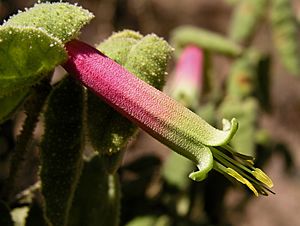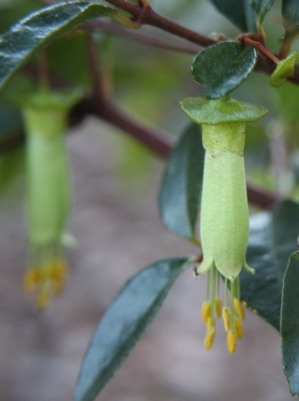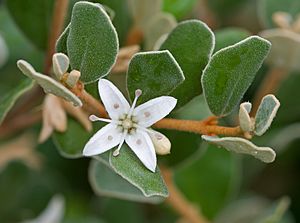Correa (plant) facts for kids
Quick facts for kids Correa (plant) |
|
|---|---|
 |
|
| Correa reflexa near Abercrombie Caves | |
| Scientific classification |
|
| Kingdom: | Plantae |
| Clade: | Tracheophytes |
| Clade: | Angiosperms |
| Clade: | Eudicots |
| Clade: | Rosids |
| Order: | Sapindales |
| Family: | Rutaceae |
| Subfamily: | Rutoideae |
| Genus: | Correa Andrews |
| Species | |
|
See text. |
|
| Synonyms | |
|
|
Correa is a group of eleven types of flowering plants that grow only in Australia. These plants are usually shrubs or small trees. They have simple leaves that grow in pairs opposite each other. Their flowers have both male and female parts. They have four small leaves called sepals and four petals that are usually joined together. Each flower also has eight stamens, which produce pollen.
Contents
What do Correa Plants Look Like?
Correa plants can be small shrubs or grow into small trees. Their leaves are simple and always grow in opposite pairs on the stem.
Correa Flowers and Fruit
The flowers of Correa plants have both male and female parts, meaning they can produce seeds on their own. They often grow in small groups in the leaf axils (where the leaf meets the stem) or at the ends of branches.
- The four sepals are usually joined at the bottom, forming a cup-shaped base for the flower.
- The four petals are mostly joined together, creating a tube-shaped flower.
- Inside, there are eight stamens, which are the parts that make pollen.
- The flowers also have four parts called carpels that are joined at the bottom. These contain the seeds.
- After the flower blooms, it forms small pods called follicles. These pods can hold up to two dull brown seeds, which are released when the pod bursts open.
Naming and History of Correa Plants
The group of plants known as Correa was first officially described in 1798. This was done by a botanist named Henry Cranke Andrews. The very first species he described was the Correa alba. The name Correa was chosen to honor a Portuguese botanist named José Correia da Serra (1750–1823), who was also known as Abbé Correa.
Different Types of Correa
There are many different types of Correa plants. Here are some of the main species and their common names, as recognized by the Australian Plant Census:
- Correa aemula – also known as hairy correa.
- Correa alba – known as white correa.
- Correa backhouseana – found in several Australian states.
- Correa baeuerlenii – often called chef's hat correa because of its unique flower shape.
- Correa calycina – known as South Australian green correa.
- Correa decumbens – called spreading correa.
- Correa eburnea – known as Deep Creek correa.
- Correa glabra – called rock correa.
- Correa lawrenceana – known as mountain correa.
- Correa pulchella – called salmon correa.
- Correa reflexa – known as common correa or native fuchsia.
Growing Correa Plants in Gardens
Many types of Correa plants are popular in Australian gardens because they are generally easy to grow. They are also great for attracting birds!
Best Conditions for Growing Correa
- Correa alba and C. glabra are very tough. They can handle strong frosts and dry weather. You can plant them in full sun or a partly shaded spot. Correa glabra also has leaves that smell nice.
- Correa lawrenceana is the largest type of Correa. These plants prefer shady spots, like under bigger trees. They are perfect for birds, providing both nectar (a sweet liquid) and safe places for nests. Planting them close together can create a good thicket for birds.
- Correa pulchella varieties have beautiful bell-shaped flowers in colors from light pink to bright orange or deep red. These need some shade and regular watering.
- Correa reflexa varieties come in colors from green to deep red. They also like partly shaded areas and need to be watered regularly.
Some Correa species, like C. eburnea and C. calycina, are rare and harder to find in plant nurseries. Many new types of Correa have been created by gardeners and registered with the Australian Cultivar Registration Authority (ACRA).
In the UK, some Correa species and special types have even won the Royal Horticultural Society's Award of Garden Merit. These include Correa backhouseana, Correa pulchella, Correa reflexa, Correa 'Dusky Bells', and Correa 'Mannii'.
See also
 In Spanish: Correa (planta) para niños
In Spanish: Correa (planta) para niños



